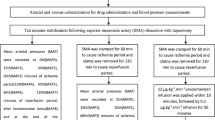Abstract.
It is suggested that gastrointestinal mucosal blood flow depends on a balanced release of vasoactive substances from the endothelium. The present study investigated the effects of molsidomine on the small intestine after ischemia-reperfusion (I/R) injury in four groups of 10 rats each composed: (1) SO, sham operation; (2) untreated I/R; (3) ML, I/R plus molsidomine pretreatment; (4) L-NAME, I/R plus N-omega-nitro-L-arginine methyl ester pretreatment. Intestinal ischemia for 45 min and reperfusion for 60 min were applied. Ileum specimens were obtained to determine the tissue level of malondialdehyde (MDA) and histologic changes. Mean MDA levels in the SO, untreated I/R, ML, and L-NAME groups were 95.60 ± 2.59, 136.90 ± 4.35, 121.10 ± 3.38, and 137.40 ± 4.42 nmol/g wet tissue, respectively. Although the MDA level in the ML group was higher than in the SO group (P < 0.0001), it was significantly lower compared to the untreated I/R and L-NAME groups (P < 0.0001, P < 0.0001). Mucosal injury scores (MIS) in groups 1–4 were 0.2 ± 0.42, 3.9 ± 0.73, 1.5 ± 0.70, and 4.1 ± 0.56, respectively. In group 3 the MIS was significantly lower than in groups 2 and 4 (P < 0.0001, P < 0.0001). Molsidomine plays a role in attenuating reperfusion injury of the small intestine by depression of tissue MDA levels and MIS and regulates post-ischemic intestinal perfusion while restoring the intestinal microcirculatory blood flow and histologic injury.

Similar content being viewed by others

References
Günel E, Çağlayan F, Çağlayan O, et al (1998) Treatment of intestinal reperfusion injury using antioxidative agents. J Pediatr Surg 33: 1536–1539
Takada K, Yamashita K, Sakurai-Yamashita Y, et al (1998) Participation of nitric oxide in the mucosal injury of rat intestine induced by ischemia-reperfusion. J PET 287: 403–407
Shah KA, Shurey S, Green CJ (1997) Apoptosis after intestinal ischemia-reperfusion injury. Transplantation 64: 1393–1397
Chen JC, Chen HM, Shyr MH, et al (2000) Selective inhibition of inducible nitric oxide in ischemia-reperfusion of rat small intestine. J Formos Med Assoc 99: 213–218
Zimmerman BJ, Granger DN (1992) Reperfusion injury. Surg Clin North Am 72: 65–83
Kukovetz WR, Holzmann S (1986) Cyclic GMP as the mediator of molsidomine-induced vasodilatation. Eur J Pharmacol 122: 130–109
Walder CE, Thiemermann C, Vane JR (1991) The involvement of endothelium-derived relaxing factor in the regulation of renal cortical blood flow in the rat. Br J Pharmacol 102: 967–973
Meigson SM, Horton JW, Chao HE, et al (1990) Prolonged survival and decreased mucosal injury after low-dose enteral allopurinol prophylaxis in mesenteric ischemia. J Pediatr Surg 25: 917–921
Yagi K (1994) Lipid peroxides in hepatic, gastrointestinal, and pancreatic diseases. In: Armstrong D (ed) Free radicals in diagnostic medicine. Plenum Press, New York, pp 165–169
Chiu CJ, Scott HJ, Gurd FN (1970) Intestinal mucosal lesion in low-flow states. II. The protective effect of intraluminal glucose as energy substrate. Arch Surg 101: 484–488
Mangino JE, Kotadia B, Mangino MJ (1996) Characterization of hypothermic intestinal ischemia-reperfusion injury in dogs. Effects of glycine. Transplantation 62: 173–178
Punch J, Rees R, Cashmer B, et al (1992) Xanthine oxidase: its role in no-reflow phenomenon. Surgery 111: 169–176
Koo A, Komatsu H, Tao G, et al (1993) Contribution of no-reflow phenomenon to hepatic injury after ischemia reperfusion: evidence for a role of superoxide anion. Hepatology 15: 507–514
Akgür FM, Olguner M, Yenici O, et al (1996) The effect of allopurinol pretreatment on intestinal hypoperfusion encountered after correction of intestinal volvulus. J Pediatr Surg 31: 1205–1207
Ruf W, Suehiro GT, Suehiro A, et al (1980) Intestinal blood flow at various intraluminal pressures in the piglet with closed abdomen. Ann Surg 191: 157–163
Caplan MS, Sun X-M, Hsueh W (1990) Hypoxia causes ischemic bowel necrosis in rats: the role of platelet-activating factor 8 (PAF-Acheter). Gastroenterology 99: 979–986
Czyrko C, Steigman C, Turley D, et al (1991) The role of reperfusion injury in occlusive intestinal ischemia of the neonate: malonaldehyde derived fluorescent products and correlation of histology. J Surg Res 51: 1–4
Otamiri TA (1988) Influence of quinacrine on plasma malondialdehyde after small intestinal ischemia and reperfusion. Circ Shock 24: 63–69
Durakbasa CU, Dagli TE, Mouni H, et al (1998) Nitric oxide and endothelin relationship in intestinal ischemia/reperfusion injury. Prostaglandins Leukot Essent Fatty Acids 59: 379–383
Reilly PM, Schiller HJ, Bulkley GB (1991) Pharmacologic approach to tissue injury mediated by free radicals and other active oxygen metabolites. Am J Surg 161: 488–503
Summers ST, Zinner MJ, Freischlag JA (1993) Production of endothelium-derived relaxing factor (EDRF) is compromised after ischemia and reperfusion. Am J Surg 166: 216–220
Davies MG, Hagen P-O (1993) The vascular endothelium: a new horizon. Ann Surg 218: 593–609
Kukovetz WR, Holzmann S (1985) Mechanism of vasodilation by molsidomine. Am Heart J 109: 637–640
Grisham MB, Hernandez LA, Granger DN (1986) Xanthine oxidase and neutrophil infiltration in intestinal ischemia. Am J Physiol 251: G567–574
Ward DT, Lawson SA, Gallagher CM, et al (2000) Sustained nitric oxide production via l-arginine administration ameliorates effects of intestinal ischemia-reperfusion. J Surg Res 89: 13–19
Mc Call T, Whittle BJR, Boughton-Smith NK, et al (1988) Inhibition of fmlp-induced aggregation of rabbit neutrophils by nitric oxide. Br J Pharmacol 95: 517P
Author information
Authors and Affiliations
Rights and permissions
About this article
Cite this article
Öztürk, H., Aldemir, M., Dokucu, A.İ. et al. The nitric oxide donor molsidomine prevents ischemia/reperfusion injury of the adult rat small intestine. Ped Surgery Int 19, 305–308 (2003). https://doi.org/10.1007/s00383-002-0746-y
Accepted:
Published:
Issue Date:
DOI: https://doi.org/10.1007/s00383-002-0746-y



